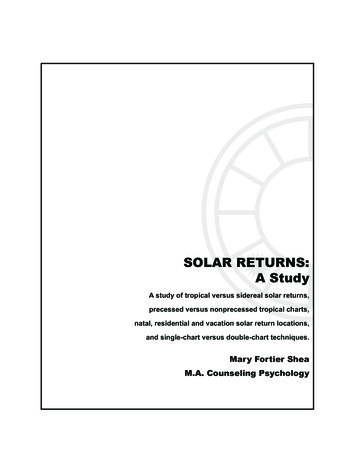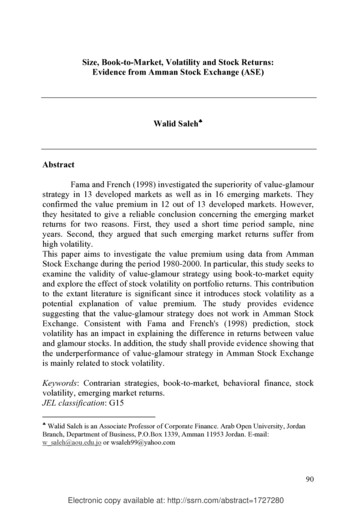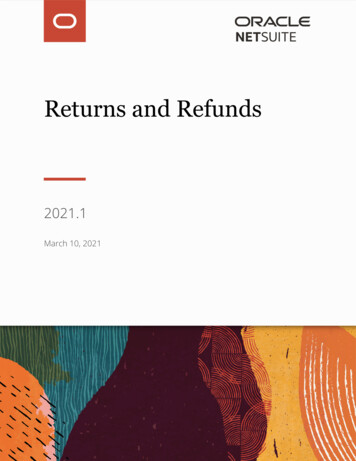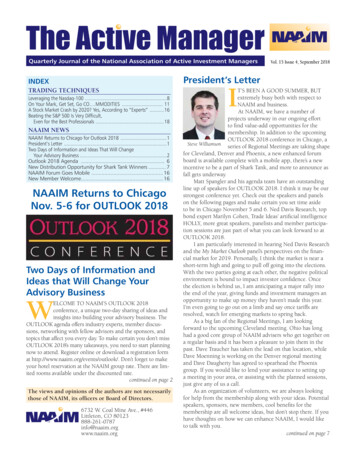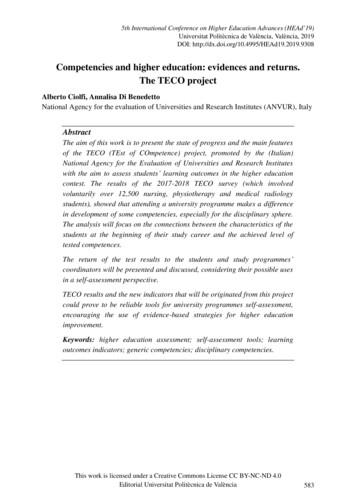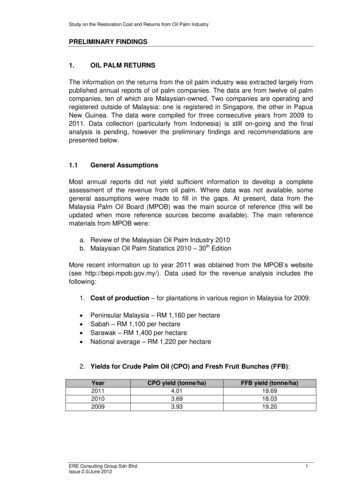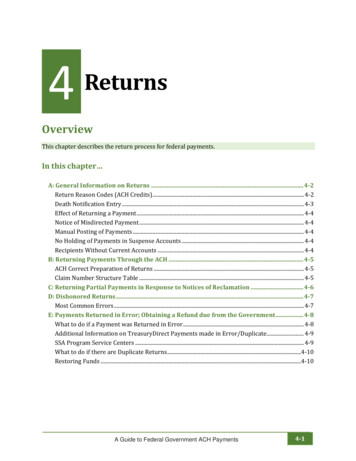
Transcription
4) Chapter 4: Returns4ReturnsOverviewThis chapter describes the return process for federal payments.In this chapter A: General Information on Returns . 4-2Return Reason Codes (ACH Credits). 4-2Death Notification Entry . 4-3Effect of Returning a Payment . 4-4Notice of Misdirected Payment . 4-4Manual Posting of Payments . 4-4No Holding of Payments in Suspense Accounts . 4-4Recipients Without Current Accounts . 4-4B: Returning Payments Through the ACH . 4-5ACH Correct Preparation of Returns . 4-5Claim Number Structure Table . 4-5C: Returning Partial Payments in Response to Notices of Reclamation . 4-6D: Dishonored Returns . 4-7Most Common Errors . 4-7E: Payments Returned in Error; Obtaining a Refund due from the Government . 4-8What to do if a Payment was Returned in Error . 4-8Additional Information on TreasuryDirect Payments made in Error/Duplicate. 4-9SSA Program Service Centers . 4-9What to do if there are Duplicate Returns.4-10Restoring Funds .4-10A Guide to Federal Government ACH Payments4-1
4. ReturnsGreen BookA: General Information on ReturnsAll ACH Payments must be returned in accordance with Nacha Operating Rules & Guidelines. AnACH payment must be returned if: An enrollment has been terminated and a new enrollment for the same recipient has not beencompleted, The financial institution receives a benefit payment after it has actual or constructiveknowledge of the death or legal incapacity of a recipient, including a representative payee, The financial institution is honoring a Death Notification Entry (DNE) or other notification ofdeath from a federal agency, The account has been closed by the recipient, or the financial institution has closed an accountto which benefit payments are being delivered after giving the recipient 30 days written notice(except where fraud is suspected; then the account may be closed immediately), There is no current account for the recipient, and For any other reason the financial institution is unable to credit the payment to the account.Return Reason Codes (ACH Credits)The government is able to accept all Nacha-approved return reason codes. Following is a list ofsome of the more common return reason codes that RDFIs use to return government credits:R02 Account ClosedR03 No Account/Unable to Locate AccountR04 Invalid Account NumberR06 Returned per ODFI’s RequestR14 Representative Payee Deceased or Unable to Continue in that CapacityR15 Beneficiary or Account Holder (Other Than a Representative Payee) DeceasedR16 Account FrozenR17 File Record Edit Criteria (Specify)R20 Non-Transaction AccountIf you must return a federal payment for any reason not listed (i.e., credit sent to a non- transactionaccount), use reason code “R20” on the return.RDFIs that learn of the death of a recipient of benefit payments from a source other than the agencyare encouraged to use reason code R15 (Beneficiary or Account Holder Deceased) or R14(Representative Payee Deceased) to notify government agencies of the death. By using these returncodes, the RDFI will satisfy both the requirement to return post-death payments that it receivesafter actual or constructive knowledge of the death, and the requirement to notify the agency of thedeath of the recipient.RDFIs are able (but not required) to use Return Reason Code R17 – File Record Edit Criteria toindicate that the RDFI believes an ACH Credit containing invalid account information was initiatedunder questionable circumstances. This use of R17 is optional at the discretion of the RDFI. ThoseRDFIs that elect to use R17 for this purpose are required to use the description “QUESTIONABLE” in4-2A Guide to Federal Government ACH Payments
4. ReturnsGreen Bookthe Addenda Information field of the return. This description in an R17 return differentiates returnsthat appear to be suspicious to the RDFI from those due to routine account number issues.Note: The existing Nacha-coordinated opt-in programs with federal and state tax agencies that allowRDFIs to return questionable tax refund ACH credits using R17 will continue unchanged. Theseprograms will not be impacted by this additional optional use of the R17 Return Reason Code. FiscalService and the IRS participate with Nacha in this program for IRS tax refund credit entries returnedas questionable. The Return Reason Code R17 will also continue to be used in its standard form forreturns involving required field errors.Death Notification EntryThe Death Notification Entry (DNE) allows federal agencies to notify financial institutions of abenefit recipient’s death. Only an agency of the federal government may originate a DNE. Currently,SSA, OPM, and RRB originate DNEs. Other federal benefit agencies may originate DNEs at a futuredate. The DNE is a zero dollar entry with an addenda record. The addenda record contains the dateof death, the deceased individual’s SSN, and the amount of the next scheduled benefit payment.Upon receipt of a DNE, the financial institution is encouraged to “flag” the deceased recipient’saccount to prevent accepting further post-death federal benefit payments. See below form commonerrors with flagging.Example: Flagging Joint AccountsA married couple own a joint account. One spouse dies. A DNE is sent from the federal benefitagency to the RDFI. The RDFI receives the DNE and the account is “flagged”. The surviving spousebecomes eligible for surviving spousal’s benefits, and a benefit payment is sent to the joint account.Since the account is “flagged,” the RDFI improperly returns the surviving spousal’s benefits with areason code of R15 (beneficiary or account holder deceased). The agency receives the returnedbenefit and processes an improper death termination for the surviving spouse. The agency alsosends an improper DNE for the surviving spouse to the RDFI.Solution: To protect joint account holders, the account should be “flagged” with another piece ofidentifying information (i.e., deceased name, SSN). This allows the joint account holder to continuereceiving their own payments. If this is not possible, a new account with a new Direct Depositauthorization should be established.Example: Flagging Erroneous Report of DeathA recipient is receiving benefits. An erroneous report of death is received by the federal benefitagency for the recipient. A DNE is sent from the agency to the RDFI and the account is “flagged”. Therecipient discovers the problem and presents proof to the agency and the RDFI of the error in thefact of death. The RDFI fails to remove the flagging from the account. The agency resends thebenefit payment to the recipient’s account, which is still “flagged”. The RDFI returns benefits with areason code for death of R15 (beneficiary or account holder deceased) to the agency based on theerroneous flagging. The agency receives the returned benefit and re-processes the deathtermination. The agency sends an improper DNE once again to the RDFI.Solution: Always remember to remove any “flagging” on an account when a report of death proves tobe erroneous.A Guide to Federal Government ACH Payments4-3
4. ReturnsGreen BookNote: If a financial institution needs to correct errors in their use of reason codes when returningfunds, they should contact the agency receiving the return. Please see Chapter 7, Contacts, for majorpaying agency contact information.Effect of Returning a PaymentAny returned payment automatically revokes the Direct Deposit authorization and may stop furtherpayments from the federal agency to a recipient’s account. The recipient should contact theauthorizing federal agency to resume payments.Notice of Misdirected PaymentIn accordance with 31 CFR part 210, if an RDFI becomes aware that an agency has originated anACH credit entry to an account that is not owned by the payee whose name appears in the ACHpayment information, the RDFI shall promptly notify the agency. An RDFI that originates a NOCentry with the correct account and/or RTN information or returns the original ACH credit entry tothe agency with the appropriate return reason code, shall be deemed to have satisfied thisrequirement.Manual Posting of PaymentsFinancial institutions may conduct a manual search of their unpostable ACH payments to determineif the payment can be posted.RDFIs may be held liable for ACH payments not processed timely or correctly. If the federalgovernment sustains a loss as a result of a financial institution’s improper handling of an entry, thefinancial institution is liable to the federal government for the loss, up to the amount of the entry.No Holding of Payments in Suspense AccountsUnder no circumstances should a financial institution hold unpostable incoming paymentsindefinitely in a suspense account, or by any other means, nor should payments otherwise be held ifany of the conditions apply on when to return a payment. Holding payments may constitute abreach of the financial institution’s warranty for the handling of federal government ACH paymentsunder regulations codified in 31 CFR part 210.Recipients Without Current AccountsA financial institution should not open a new account in response to an unpostable payment. If arecipient’s account has been closed, the financial institution must return any subsequent paymentsmade by the federal agency to the account. If the recipient closes the account and opens a newaccount, the recipient must establish a new Direct Deposit authorization.4-4A Guide to Federal Government ACH Payments
4. ReturnsGreen BookB: Returning Payments Through the ACHACH Correct Preparation of ReturnsIt is essential that RDFI employees preparing returns have access to data in the original itemoriginated by the government disbursing office. If a processor is used, RDFIs should be sure that thereturn entry is properly formatted to include the data from the original entry.“When a Return Entry is prepared, the original Company/Batch Header Record, the original EntryDetail Record, and the Company/Batch Control Record are copied for return to the Originator”(Nacha Operating Rules & Guidelines). If accurate data is not provided in the return entry, thegovernment disbursing office will dishonor the return.The following four fields must be identical to the original payment data:1. Trace number (provided in the entry detail record),2. Effective entry date,3. Amount of payment, and4. Individual ID number (i.e., claim number. See the Claim Number Structure Table below).Note: Financial institutions using data processors could receive reformatted data which may containerrors or omissions. The original payment information must be used in its exact format to avoidrejections.Financial institutions should carefully track returned benefit payments to ensure that the returnsare not dishonored. This could create an additional liability for the financial institution in areclamation case.Claim Number Structure TableThe following table represents correct claim number structures used in formatting returns.AGENCYCLAIM NUMBER STRUCTUREEXAMPLESocial Security b99162306890 10 0112345678 00 06Office of Personnel ManagementDepartment of Veterans AffairsRailroad Retirement ment of LaborKey:X 999XXbXXb9 numeric,b blank,F 1234567 WA 1234567 0WCA123456789 7A 123456 1WD 000006 8123456789123456789LW MBZ zero filled,A Guide to Federal Government ACH Payments space4-5
4. ReturnsGreen BookC: Returning Partial Payments in Response to Notices ofReclamationPayments should be returned by ACH except in limited circumstances. If a partial payment is beingreturned in response to a Notice of Reclamation (FS Form 133), a financial institution can elect toeither have their account debited for the partial payment, or, alternatively, returned by check. In noother case should ACH returns be made by check, except as described in the Note below. Pleaserefer to Chapter 5, Reclamations, for more information including how to request an ACH debitauthorization.Note: If the original payment data is not available, a financial institution may be forced to return anACH payment by check. The financial institution will receive credit. However, in these cases, credit willbe delayed due to manual processing. Note that under Nacha Operating Rules & Guidelines, records ofall entries including return and adjustment entries must be retained for six years from the date theentry was transmitted.The table below shows how to return a partial payment by check in response to a Notice ofReclamation.STEP12ACTIONSend the government disbursing office a check payable as indicated on item C-3b on the Notice ofReclamation.DO NOT SEND THE CHECK TO THE ORIGINATING FEDERAL AGENCY.Attach a cover letter listing the following information for each payment subject to return: effective entry date, amount of payment, individual identification number (i.e., SSN/claim number), and reason for return.If the above payment information is not available, provide the following information: recipient’s name, recipient’s SSN or other applicable federal government identification number, date of death, and name of originating federal agency.The cover letter must always include: recipient’s name, and name of originating federal agency.Provide the name, address, and telephone number of the financial institution contact.4-6A Guide to Federal Government ACH Payments
4. ReturnsGreen BookD: Dishonored ReturnsACH return items will be dishonored by the government disbursing office if discrepancies existbetween the data on the return item and the data on the original payment.Most Common ErrorsFor Treasury-disbursed payments, four fields are read on return items. If any one of these fourfields are not identical to the original payment data, Treasury will dishonor the return.The following four fields must be identical to the original payment data:1. Original Entry Trace Number (provide in the addenda record),2. Effective entry date (i.e., payment date),3. Amount of payment, and4. Individual ID number (i.e., claim number).The discretionary data field on the return item should be left blank ONLY if it was blank in theoriginal ACH entry. If the field contains data in the original entry, the exact same data must beincluded in the return entry.Note that a VA claim number may be an 8-digit number with a blank in the leading space of theindividual ID field. If the space is ignored, and the number is left-justified, the return will bedishonored. (See the claim number structure table on page 4-5.)If a financial institution receives a dishonored return, the financial institution should correct theinformation in the return and originate a new return in accordance with Nacha Operating Rules &Guidelines.Dishonored Return Codes: R61 - Misrouted Return R67 - Duplicate Return R68 - Untimely Return R69 - Field Errors (the error(s) will be identified in the Addenda Information field on thedishonored file positions 59-79. The two-digit code, separated by an asterisk, will be writtenfor each error found.)01 - Return Contains Incorrect DFI Account Number02 - Return Contains Incorrect Original Entry Trace Number03 - Return Contains Incorrect Dollar Amount04 - Return Contains Incorrect Individual Identification Number/Identification Number05 - Return Contains Incorrect Transaction Code06 - Return Contains Incorrect Company Identification Number07 - Return Contains an Invalid Effective Entry Date R70 - Permissible Return Entry Not AcceptedA Guide to Federal Government ACH Payments4-7
4. ReturnsGreen BookE: Payments Returned in Error; Obtaining a Refund due fromthe GovernmentIf a financial institution needs to correct errors in their use of reason codes when returning funds,they should contact the agency receiving the return. Please see Chapter 7, Contacts, for majorpaying agency contact information. Any payment returned for “death” will cancel both the DirectDeposit authorization and the recipient’s entitlement to that payment.If you are due a refund from the government under ACH, regardless of whether you have returnedtoo much, returned the wrong item(s), or the government debited you too much (e.g., on an ACHreclamation), follow these instructions to claim your refund.Please note that the RDFI is not required to advance credit to the recipient for a payment returnedin error. However, if the RDFI did advance credit, it should state this in any communication with thefederal agency.What to do if a Payment was Returned in ErrorACTION1.STEPSContact the federal agency that authorized the payment. Do not contact the governmentdisbursing office.Payment TypeContactOPM Annuity(formerly Civil Service Retirement)“CIVIL SERV”U.S. Office of Personnel ManagementP.O. Box 45Boyers, PA 16017(724) 794-2005Supplemental Social Security Income“SUPP SEC”Social Security AdministrationCertification and Accounting Branch, AnalystRoom 3-A-2 East High Rise Building6401 Security BoulevardBaltimore, MD 21235(410) 966-5353Social Security“SOC SEC”SSA Program Service Center (Refer to SSA Program ServiceCenters section in this chapter for appropriate addresses).Bureau of the Fiscal ServiceCustomer Assistance BranchWarehouse and Operations Center, Dock 1257 Bosley Industrial Park DriveParkersburg, WV 26101(304) 480-7591Fiscal Service“TreasuryDirect”Note: Include with your letter a debit advice, Return Item- Credit Form, and any other documents thatconfirm the duplicate or erroneous return.VA Compensation or Pension“VA BENEFIT”None.Railroad Retirement BoardRailroad Retirement Board Direct Deposit Coordinator(312) 751-4704Note: Payments returned to the VA in error cannot be recalled. They will be reissued to the recipient’shome address.For all other payment types4-8The federal agency’s local office listed in the t
Green Book 4-2 A Guide to Federal Government ACH Payments A: General Information on Returns All ACH Payments must be returned in accordance with Nacha Operating Rules & Guidelines. An ACH payment must be returned if: An enrollment has been terminated and a new


